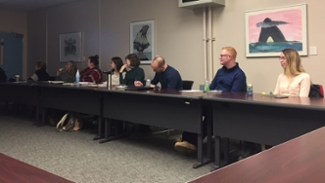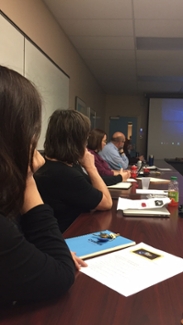Lights, Camera, Action: Experiential Learning Project Presentations
Fri. Jan. 4, 2019
In 2017 and 2018, faculty members were invited to apply for funding to support “experiential learning” projects, or learning opportunities that have a “hands-on” or out-of-classroom component, such as field courses/schools, learning practica, etc. On November 16, 2018, Experiential Learning Fund (ELF) recipients gathered to present their work in presentations of 8 to 10 minutes.
 Presenters at EL Project Presentations
Presenters at EL Project Presentations
Dr. Jaqueline McLeod Rogers, Acting Associate Dean of Arts and Chair of the Experiential Learning Committee (ELC) in 2018, welcomed members of the ELC and the presenters, before introducing Dr. James Currie, Vice-President Academic and Provost. Dr. Currie commented on the diversity in the presentations involving experiential learning and noted the important links with the community that are represented in these.
Experiential learning and the community
 Presenters at the Nov. 16, 2018 event
Presenters at the Nov. 16, 2018 event
Indeed, the presentations came from departments in the Faculties of Arts, Science and Education, as well as from the Human Rights Program and the Conflict Resolution Program in Menno Simons College, and several of these involved connections with the community. For example, Biology professor, Dr. Germán Avila-Sakar, wanted to engage students along with members of the community to do the work that botanists do. His project “Urban Community Gardens”, saw students working with community gardeners in the city’s Spence Neighbourhood in which the University is situated.
Dr. Shauna MacKinnon, Chair of the Department of Urban and Inner-City Studies, was funded for her project “Youth United@Winnipeg: Indigenous and Non-Indigenous Youth Programming”. Through the program, students get paid employment with local organizations, work experience, which she says, is valuable to the students, and which has led to some students being hired by the organizations. Indigenous Elders worked with the students, providing Indigenous knowledge as well guidance and support when students were struggling with difficult issues. According to Dr. MacKinnon, the project is about “reconciliation in action, building partnerships, and bridging divides.”
Dr. Judith Harris and Dr. Kevin Walby’s project “Canadian Prison Education: Taking a Walls to Bridges Approach” provided the opportunity to connect incarcerated students with the community in an innovative way. Through the Walls to Bridges program, campus-enrolled students attend university classes with incarcerated students inside the prison. Drs. Harris and Walby introduced a former student of the program, Betha Cacho, who had completed 15 months of a 22-month sentence at the Women’s Correctional Centre when she took an English course,“Contemporary Indigenous Literature”, with Dr. Kathleen Venema. Betha Cacho shared that during the course, she experienced a shift in identity, one which she feels freed her of her former life. In this way, Walls to Bridges, she says, has the potential to reduce recidivism.
Travel courses
While Dr. Avila-Sakar and Dr. MacKinnon’s projects are local, others are literally farther afield. History professor, Dr. Roland Bohr, has designed a field course, “Material Culture in the Northern Plains Indigenous History: ANPO Bison Ranch”. Students travelled to a bison ranch near Rossburn, Manitoba, where they learned how to make and use Indigenous technology that would have been used in the mid-1800’s in this area. The course, Dr. Bohr says, has had some unexpected learning outcomes, one of which involved the students’ experience tanning a moose hide using a fleshing tool. The work, he says, is labour intensive, so students started rotating and sparing one another off, such that the work continued to progress quickly, but was also a pleasant experience. Bohr likened this to the traditional work ethic of the Indigenous peoples and was something students took away from the course.
Dr. Dean Peachey, a professor in the Human Rights Program, took students even farther afield for his project: “Field Trip to the West Bank, Israel: Quest for Peace and Justice”. Students met with NGOs, human rights workers, peace workers, as well as students who live and study in the West Bank, and they visited sites such as the Yad Vashem, a large Holocaust memorial. Dr. Peachey talked about the connections that students make with one another. From his experience, the bonds that are created during the course, are often lasting bonds, as the students tend to find themselves looking to one another in the days and weeks after their return home, as they can feel a need to relate to others who have shared experience.
Similarly, Dr. Mirjana Roksandic’s project “Field Trip and Paleoanthropology in Serbia: Saltena Pecina” involved travel overseas, in this case to an archeological dig site in Western Serbia. Two of Dr. Roksandic’s students, Lydia Epp and Milena Zdjelar, described how they learned first-hand how to perform the skills they’d learned about in class. Evenings, they said, were spent listening to lectures and/or documenting the finds of the day. Milena Zdjelar explained that, as they’d progress through the different layers of sediment, their finds would correspond to different periods in time, just as they’d learned in class. She added that it’s been her “favourite course” to date. Lydia Epp says they were able to ask a lot of questions and get one-on-one help. Both say that students in the course have kept in touch with one another and with their professors.
Opportunities for engaged students
Geography professor, Dr. Nora Casson’s project didn’t involve travel, but as with the travel courses, her project “Linked Undergrad Experience on Nutrients”, did involve creating an outstanding learning experience for engaged students. Dr. Casson explained that the way science is being done is changing with a marked increase in collaborative research, so she wanted to incorporate this into the undergraduate program. With funding she received from the ELF, she was able to coordinate with academics in other institutions, so that students were linked with researchers in other universities to do experiments. Students had the opportunity to develop protocol for collaboration, collaboratively write manuscripts, and to develop a broad professional network. Dr. Casson said that the project could potentially be applied in other disciplines as well.
Dr. Shelley Tulloch and Dr. Eric Thrift are faculty members in Anthropology. Their project, “Instructional Support for Course-based Ethnographic Research”, was designed to give undergraduate students what they need to conduct ethnographic research, by providing the models, templates, instructions, and assessment criteria that researchers need in order to conduct this type of work. Once completed, their project has the potential to be used in classrooms again and again, as well in other contexts. For example, Dr. Thrift suggests it could be used in an undergraduate program to teach research methods in the higher levels when there aren’t enough students to offer this as a course.
Teaching resources and education
Similarly, in their project, “Mainstreaming Experiential Education through In-Class Activity Toolkits”, Professors Julie Hyde and Karen Ridd, faculty members in the Conflict Resolution Program, were concerned with creating a product that can be used repeatedly in various contexts. As Prof. Hyde explained, while experiential learning is often valued, its use is often constrained by factors such as preparation time and cost, scheduling and accessibility, and pedagogical effectiveness (will it work). With their funds from the ELF, they’re creating 10-15 activity toolkits, combining these with training and well thought out assessment methods that have been tested. Through their vision, a modest amount of funding is being used to enrich the education of many students.
Dr. Dawn Sutherland is a professor in the Faculty of Education. Her project, “DESTINATION IMAGINATION: In-school Learning Community”, involves working with DESTINATION IMAGINATION (DI), a non-profit educational organization that facilitates programming which is designed to engage children in long-term problem solving. Funds from the ELF covered the entrance fee for DI. Student teachers candidates work with a cooperating teacher and with teams of up to seven children on year-long projects. Dr. Sutherland herself has seven DI teachers, which means that as many as 49 children could be impacted by this innovative program. Children select one of a variety of challenges and develop solutions. Teachers are not to impede the process, “the non-interference clause”, and can only skillbuild with the children. It’s up to the children to come with the ideas themselves!
Dr. Ken Reimer is also a faculty member in Education. For his project, “Designing our Tomorrow Teams in Education”, he worked in conjunction with “Sympathetic Engineering”, a program in the Department of Engineering at Cambridge University. Through it, students use devices to simulate what it’s like to experience a particular physical limitation. For example, there are goggles students can try which simulate the type of vision impairment experienced by individuals with cataracts. And, there are gloves which allow students to experience what it might be like to have arthritis. Student then try to solve real life problems by designing something that would be useful for someone with that condition. Dr. Reimer showed a video of students at Sisler High School in Winnipeg’s North End engaged in the program. The amazing video that was created by the students themselves will be viewed at Cambridge University and around the world.
Value and impact
What is clear in all of the presentations is the energy and the commitment of faculty to creating outstanding learning opportunities for students. Using the (modest) funds awarded, the presenters provided opportunities that: (i) made and strengthened connections with the community and the potential for reconciliation (Avila-Sakar, MacKinnon, Harris & Walby, Bohr), (ii) allowed for hands-on learning/skillbuilding/job training (Tulloch & Thrift, Bohr, Avila-Sakar, Casson, Sutherland, Hyde & Ridd, Sutherland, MacKinnon, Roksandic, Reimer), (iii) enabled senior students to challenge themselves in ways that prepare themselves for graduate work (Tulloch & Thrift, Casson, Roksandic), (iv) allowed for students to learn more about their own culture and context through travel (Bohr, Peachey, Roksandic), and (v) engaged children and youth in activities which strengthen their capacity to be empathetic and to problem solve (Sutherland, Reimer).
Lights, Camera, Action: Experiential Learning Project Presentations - program
